But think about a miner trapped underground after an accident.Or a firefighter who rushes into a smoke- and flame-filled building.Or, more poignantly, an equipment-laden rescuer walking up the stairs in the doomed World Trade Center.
How can emergency incident commanders pinpoint the location of these people?
At present, they can't.
In the days after September 11, that fact began to trouble researchers at the National Personal Protective Technology Laboratory in Pittsburgh.The lab's mission is to prevent work-related injury and illness by ensuring the development, certification, deployment and use of personal protective equipment and "fully integrated intelligent ensembles" used by firefighters and other first responders.
In thinking about how to track people indoors, it seemed clear that GPS would not be an option.High frequencies but low signal strength made traditional positioning technology unreliable.
Traditional two-way radio communications can be problematic, too. Emergency response agencies have complained about those deficiencies for years.And even if radios did work, how can a trapped miner or endangered firefighter accurately describe his or her location?
As options were considered and discarded, "we scratched our heads," says Tom Fisher, a senior research scientist at NPPTL.Having spent much of his career with the U.S.Bureau of Mines where he managed an electronics division, Fisher now devotes his time to solving safety problems that can mean the difference between life and death for emergency first responders.
One idea that seemed worth pursuing was to use dead reckoning aided by an inertial gyroscope.Gyroscopes are essentially wheels mounted so that they can spin about an axis in any direction.Once a gyroscope begins spinning it tends to resist any change in the orientation of its spin axis.This makes it particularly useful in ship stabilizers to counteract rolling.Gyroscopes also lie at the heart of most automatic steering systems, like those used in airplanes, missiles and torpedoes.
But as the basis for a piece of emergency responder gear, expense and size were a major concern.And it seems that relatively inexpensive gyroscopes can be subject to a lot of drift, Fisher says.Positional errors can add up rapidly.That's a critical problem when trying to track a firefighter in a dark, smoke-filled building.
6 feet and 60 minutes
The NPPTL development team wanted a tracking system accurate to within 6 feet after 60 minutes of use.Six feet, Fisher points out, is roughly the distance an average adult male can spread his arms while reaching blindly along a wall.And 60 minutes roughly equals the amount of oxygen a firefighter carries into a building.
Given the gyroscope's inherent limitations, an approach capable of more accurate tracking was needed.
Fisher called Dr. William L."Red" Whittaker at nearby Carnegie Mellon University for advice.Whittaker is the Fredkin Professor of Robotics, Director of the Field Robotics Center, and founder of the National Robotics Engineering Consortium.
Whittaker suggested using a micro electro-mechanical systems (MEMS) type of gyroscope.MEMS are mechanical devices built onto semiconductor chips.They are small enough to be measured in micrometers and are used to make pressure, temperature, chemical and vibration sensors, light reflectors and switches as well as accelerometers for automobile airbags, vehicle control, pacemakers and games.Newer accelerometers use a heated gas bubble with thermal sensors.They operate much like the air bubble in a construction level.When the accelerometer is tilted or accelerated, sensors pick up the location of the gas bubble.
NPPTL liked the idea and awarded Carnegie Mellon an initial $100,000 contract to mock up a device in 2002."It was a nice demonstration but inaccurate," Fisher recalls.A follow-on contract worth $250,000 was awarded for second and third-generation prototypes.
To improve a MEMS-based locator's accuracy, Carnegie Mellon's research team, led by Dr.Scott M.Thayer, system scientist, elected to use three sensors: one on each leg and a third worn at the waist.This configuration would allow the system to reconstruct the person's gait as he or she moved around.Importantly, explains Fisher, in this application the gyroscope needed to remain stable only for as long as it took a person to lift her foot and set it down again.The accelerometer would measure the change in motion at each step and transmit that information to a Bluetooth wireless device worn at the waist.That device, in turn, sent a constant stream of tracking data to an incident command center outside of the building.There, incident commanders could monitor the location of people inside the building.
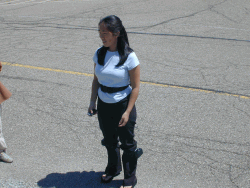 Demonstration of the apparatus |
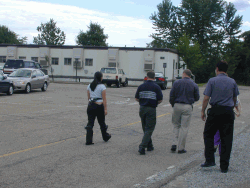 Demonstration of the apparatus in a parking lot |
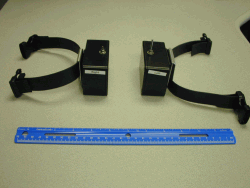 Leg devices |
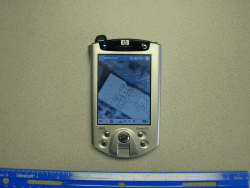 Palm Pilot |
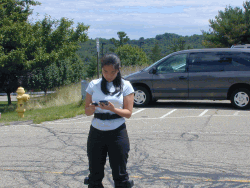 Reviewing the data |
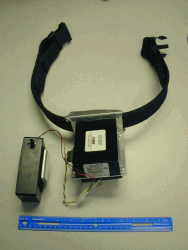 Waist Pack |
The prototype's most recent demonstration took place January 20 in Pittsburgh and went "extremely well," Fisher says.During the demonstration a team of two "emergency responders" were able to simultaneously report their position, status and current course of actions to a base station.Also demonstrated was a personal data assistant-based multi-port display.This allowed several people to view the tracking and mapping.And the Carnegie Mellon team also demonstrated a remote viewing capability for the commander's base station.This enabled the tracking and mapping results to be projected onto a large screen for audience viewing.
Another prototype demonstration is set for March.After that, the NPPTL will decide whether or not to commit up to $1 million on field-testing the technology.
If it proves viable, the technology could help protect the lives of people like miners and emergency first responders.